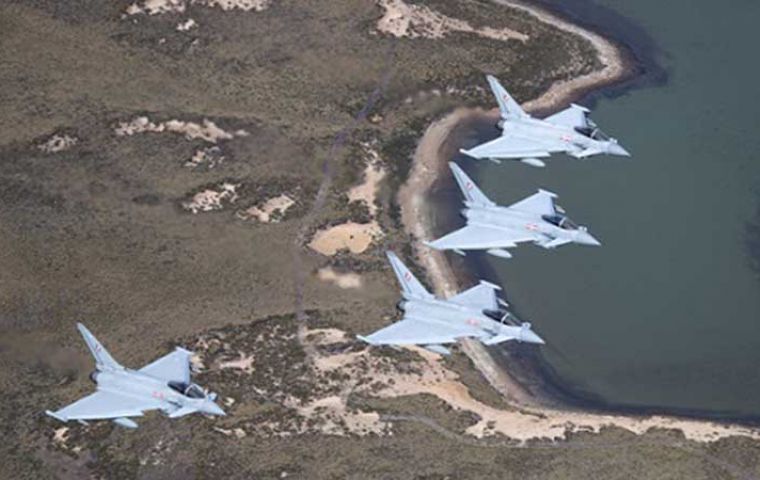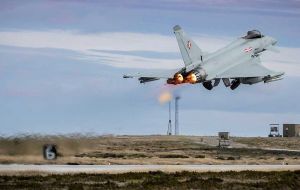MercoPress. South Atlantic News Agency
RAF’s Tranche 1 Typhoons in Falklands until at least 2027
 MoD said that four will remain on quick reaction alert duties with 1435 Flight in the Falkland Islands until 2027
MoD said that four will remain on quick reaction alert duties with 1435 Flight in the Falkland Islands until 2027 The United Kingdom has retired from service most of its remaining early model Tranche 1 Eurofighter Typhoon combat aircraft, retaining only a small number to provide air defense for the country's South Atlantic Overseas Territories, that is the Falkland Islands, according to Janes, a renowned defense and security intelligence website.
The long-heralded retirement, which began in increments from 2015, was concluded on 31 March, with the UK Ministry of Defense (MoD) confirming to Janes the formal withdrawal of most of the last of the Royal Air Force's (RAF's) original fleet of 53 Tranche 1 Typhoons.
With 49 aircraft in the official inventory at the time of retirement, the MoD said that four will remain on quick reaction alert duties with 1435 Flight in the Falkland Islands until 2027, 10 will be used for spares for the remaining Tranche 2 and Tranche 3 aircraft, 17 will be disposed of, 12 will be in storage for disposal, four will be used for ground training aids, and two are being considered for sale.
The Tranche 1 aircraft first entered service in 2003, and without the more advanced avionics and mission systems of later tranches were only supposed to remain operational for about 20 years. However, with the RAF facing a ‘fighter gap' between the withdrawal of the Panavia Tornado GR4 fleet and the building up of the Lockheed Martin F-35B Lightning fleet, it was decided in the Strategic Defense and Security Review (SDSR) of 2015 that the Tranche 1 fleet would be extended until 2040 to add much-needed combat mass.
Meanwhile UKDJ another defense and intelligence website is reporting that the UK government has signaled its openness to future collaboration with Canada on the Global Combat Air Program (GCAP), the international effort to develop a next-generation fighter jet by 2035.
In response to a written parliamentary question from Liberal Democrat MP David Chadwick, Defense Minister Maria Eagle said that while Canada is not currently a GCAP partner, the door remains open: “All three Global Combat Air Program nations have highlighted an openness to working with other nations, while keeping us on track with the program delivery schedule and helping us deliver future military capabilities.”
GCAP is a trilateral initiative between the United Kingdom, Japan, and Italy to develop a sixth-generation combat aircraft, combining stealth, advanced sensors, artificial intelligence, and next-gen weapons systems. The program will succeed the Eurofighter Typhoon and Japan’s F-2 fleet, and has been presented as a flagship example of defense industrial cooperation across continents.
Although not part of the initial group, Canada has been suggested by some analysts as a natural future partner due to its deep security ties with the UK and membership in the Five Eyes intelligence alliance.
It also recently chose the F-35 for its next fighter aircraft, aligning it with GCAP members already operating or procuring the same jet.
The Global Combat Air Program is a trilateral initiative launched in December 2022 by the United Kingdom, Japan, and Italy to develop a sixth-generation multirole stealth fighter aircraft. It merges two previously separate projects—the UK-Italy-led Tempest and Japan’s F-X—into a single platform intended to replace the Eurofighter Typhoon and Mitsubishi F-2 in their respective air forces by 2035. The collaboration aims to create a technologically advanced combat system featuring artificial intelligence, manned-unmanned teaming, and integrated sensors, with a demonstrator aircraft expected to fly by 2027.
The program is coordinated by the GCAP International Government Organization (GIGO), headquartered in the UK, and will be jointly developed by BAE Systems, Mitsubishi Heavy Industries, and Leonardo S.p.A., alongside a wide network of over 1,000 suppliers. (Pictures from Dynamic Vectors and RAF).





Top Comments
Disclaimer & comment rulesCommenting for this story is now closed.
If you have a Facebook account, become a fan and comment on our Facebook Page!